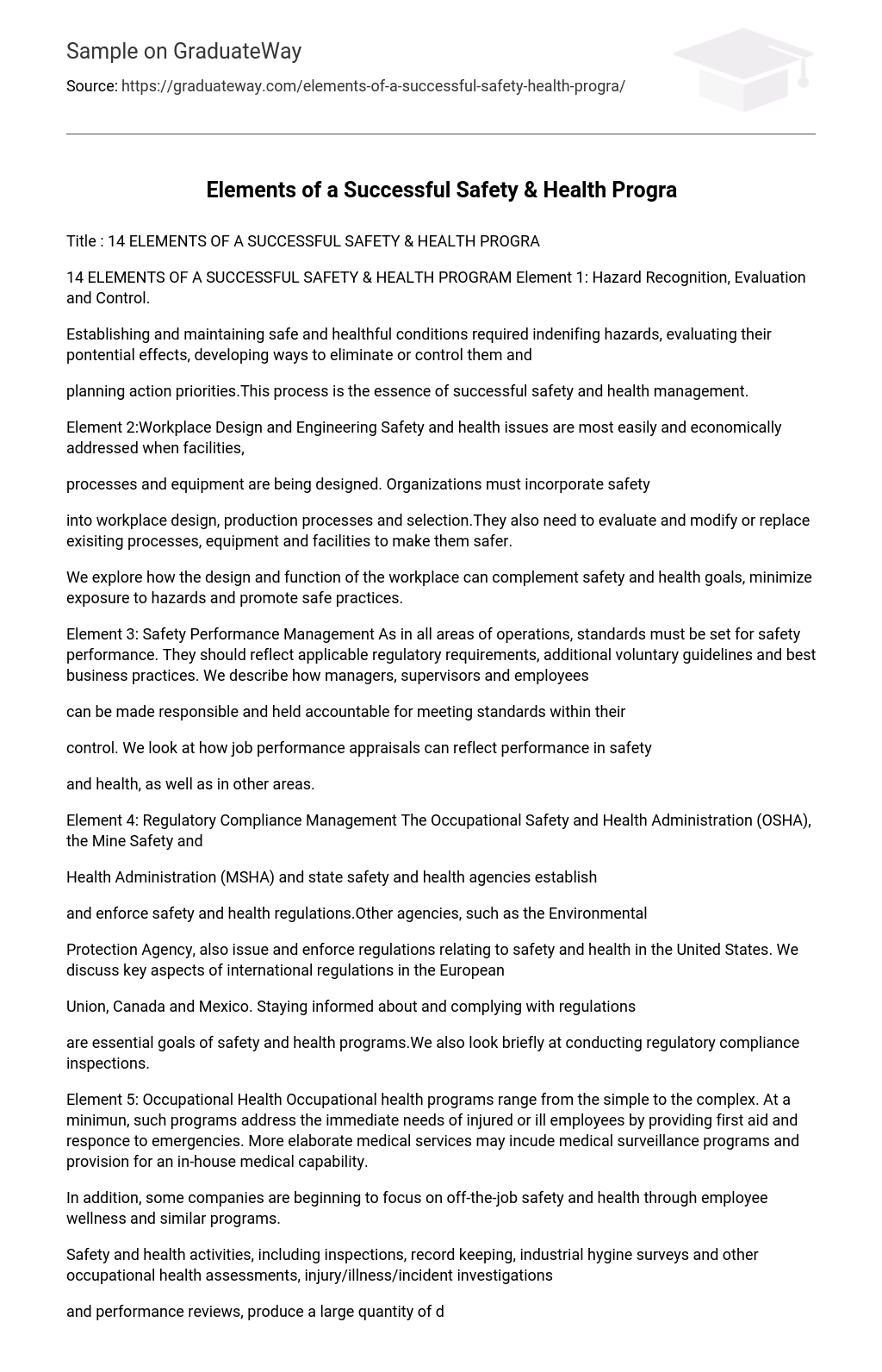- Element 1: Hazard Recognition, Evaluation and Control. Establishing and maintaining safe and healthful conditions required indenifing hazards, evaluating their pontential effects, developing ways to eliminate or control them and planning action priorities.This process is the essence of successful safety and health management.
- Element 2:Workplace Design and Engineering Safety and health issues are most easily and economically addressed when facilities, processes and equipment are being designed. Organizations must incorporate safety into workplace design, production processes and selection.They also need to evaluate and modify or replace exisiting processes, equipment and facilities to make them safer. We explore how the design and function of the workplace can complement safety and health goals, minimize exposure to hazards and promote safe practices.
- Element 3: Safety Performance Management As in all areas of operations, standards must be set for safety performance. They should reflect applicable regulatory requirements, additional voluntary guidelines and best business practices. We describe how managers, supervisors and employees can be made responsible and held accountable for meeting standards within their control. We look at how job performance appraisals can reflect performance in safety and health, as well as in other areas.
- Element 4: Regulatory Compliance Management The Occupational Safety and Health Administration (OSHA), the Mine Safety and Health Administration (MSHA) and state safety and health agencies establish and enforce safety and health regulations.Other agencies, such as the Environmental Protection Agency, also issue and enforce regulations relating to safety and health in the United States. We discuss key aspects of international regulations in the European Union, Canada and Mexico. Staying informed about and complying with regulations are essential goals of safety and health programs.We also look briefly at conducting regulatory compliance inspections.
- Element 5: Occupational Health Occupational health programs range from the simple to the complex. At a minimun, such programs address the immediate needs of injured or ill employees by providing first aid and responce to emergencies. More elaborate medical services may incude medical surveillance programs and provision for an in-house medical capability. In addition, some companies are beginning to focus on off-the-job safety and health through employee wellness and similar programs.
- ELEMENT 6: Employee Involvement Design and engineering controls are limited in their ability to reduce hazards. Companies now understand that their real assets are people, not machinery, and they also realize that employees must recognize their stake in a safe and healthful workplace. As employees become more involved in planning, implementation and improvement, they see the need for safer work practices. Solutions to safety and health problems often come from affected employees. We look at how employees can contribute to safety and health objectives through safety committees and teams.
- ELEMENT 7: Motivation, Behavior, and Attitudes Movtivation aims at changing behavior and attitudes to create a safer, healthier workplace. This elements describe two general approches organizations use to motivate employees and stresses the role that visible management leadership plays in changing unsafe or unhealthy behaviors and attitudes. It also describes three motivational techniques: communications, incentives/awards/recognition and employee surveys. New and transferred employees must become familiar with company policies and procedures and learn how to perform thier jobs safely and efficiently. The use of on-the-job, classroom and specialty training can contribute to a successful safety and health program. A complete program includes hazard recognition, regulatory compliance and prevention. The training is reinforced through regular follow-up with both new and veteran employees.
- ELEMENT 8: Organizational Communications Effective communication within the organization keeps employees informed about policies, procedures, goals and progress. We see how to spread the word about safety and health programs inside the company through the use of bulletin board notices,newsletters, meeting and other devices. Effective two-way communications between employees and managers is critical as is publicizing safety and health
- ELEMENT 9:Management and Control of External Exposures Todays safety and health programs must address risks beyond the organizations walls. We described the kinds of contingency plans and “what if” worst-case scenarios that are part of planning for disasters, contractor activities and product and other liability exposures.
- ELEMENT 10:Workplace Planning and Staffing Safety and health considerations are important when planning for and staffing the companys work force. We consider issues such as work safety rules, employee assistance programs and requirements resulting from the American with Disabilities
- ELEMENT 11:Assessments, Audits, and Evaluations Every organizations needs tools to measure conditions, monitor compliance and assess progress. A variety of evaluative tools can be used to meet the needs of the organizations, including self- assessments, third-party assessments and voluntary regulatory assessments. Numerous resources are available for conducting assessments audits and evaluations, including the companys own trained internal staff, consultants The Continuous Improvement Model is a framework for safety presented in the National Safety Councils Agenda 2000 Safety Health Environment Program.
Elements of a Successful Safety & Health Progra
Cite this page
Elements of a Successful Safety & Health Progra. (2018, Jun 24). Retrieved from
https://graduateway.com/elements-of-a-successful-safety-health-progra/





